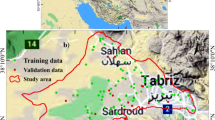Abstract
Knowledge of groundwater level is very important in studies dealing with utilization and management of groundwater supply. Earlier studies have reported that ELM performs better than SVM for groundwater level prediction. This has been verified by comparing the prediction of groundwater levels at six locations in the district of Vizianagaram, Andhra Pradesh, using ANN, GP, SVM and ELM. Based on the comparison, it is observed that the performance of ELM is the best compared to other models. ELM is capable of predicting the nonlinear behavior of the groundwater levels. SVM performs better than GP and ANN. The performance of GP and ANN is analogous. Furthermore, an attempt has been made to enhance the performance of SVM by using SVM hybrid models such as SVM-QPSO and SVM-RBF, and the same has been compared with SVM and ELM. Results indicate that the performance of SVM-QPSO is far better compared to the performance of SVM and SVM-RBF. Moreover, performance of ELM is observed to be the best, but on some occasions, SVM-QPSO performs on par with ELM.













Similar content being viewed by others
References
Affandi A, Watanabe K (2007) Daily groundwater level fluctuation forecasting using soft computing technique. Nat Sci 5:1–10
Alizamir M, Kisi O, Kermani MZ (2018) Modelling long-term groundwater fluctuations by extreme learning machine using hydro-climatic data. Hydrol Sci J 63(1):63–73
Anderson M, Woessner W (1991) Applied groundwater modeling simulation of flow and advective transport. Academic Press, San Diego, CA
Asefa T, Kemblowski MW, Urroz G, McKee M, Khalil A (2004) Support vectors-based groundwater head observation networks design. Water Resour Res 40:1–14
Balavalikar S, Nayak P, Shenoy N, Nayak K (2018) Particle swarm optimization based artificial neural network model for forecasting groundwater level in Udupi district. AIP Conf Proc 1952(1):020021
Coppola E, Szidarovszky F, Poulton M, Charles E (2003) Artificial neural network approach for predicting transient water levels in a multilayered groundwater system under variable state, pumping, and climate conditions. J Hydrol Eng ASCE 8(6):348–360
Coppola E, Rana A, Poulton M, Szidarovszky F, Uhl V (2005) A neural network model for predicting water table elevations. Ground Water 43:231–241
Coppola E, Szidarovszky F, Davis D (2007) Multiobjective analysis of a public wellfield using artificial neural networks. Ground Water 45:53–61
Coulibaly P, Anctil F, Aravena R, Bobee B (2001) Artificial neural network modeling of water table depth fluctuation. Water Resour Res 37:885–896
Daliakopoulos L, Coulibaly P, Tsanis I (2005) Ground water level forecasting using artificial neural networks. J Hydrol 309:229–240
Dash NB, Panda SN, Ramesan R, Sahoo N (2010) Hybrid neural modeling for groundwater level prediction. Neural Comput Appl 19:1253–1261
Dawson CW, Wilby R (2001) Hydrological modelling using artificial neural networks. Prog Phys Geogr 25(1):80–108
Fallah-Mehdipour E, Bozorg Haddad O, Mariño MA (2013) Prediction and simulation of monthly groundwater levels by genetic programming. J Hydro Environ Res 7:253–260
Feng S, Kang S, Huo Z, Chen S, Mao X (2008) Neural networks to simulate regional ground water levels affected by human activities. Ground Water 46:80–90
Guzman SM, Paz OJ, Tagert MLM, Mercer AE (2018) Evaluation of seasonally classified inputs for the prediction of daily groundwater levels: NARX models vs support vector machines. Environ Model Assess. https://doi.org/10.1007/s10666-018-9639-x
Huang GB, Zhu QY, Siew CK (2004) Extreme learning machine: a new learning scheme of feedforward neural networks. In: Proceedings of the international joint conference on neural networks, 25–29 July 2004, Budapest, Hungary, vol 2, pp 985–990
Huang GB, Wang DH, Lan Y (2011) Extreme learning machines: a survey. Int J Mach Learn Cybern 2(2):107–122
Jalalkamali A, Jalalkamali N (2011) Groundwater modeling using hybrid of artificial neural network with genetic algorithm. Afr J Agric Res 6:5775–5784
Kaya YZ, Unes F, Demirci M, Tasar B, Varcin H (2018) Groundwater level prediction using artificial neural network and M5 tree models. In: Conference: air and water components of environment, March, Cluj-Napoca, pp 195–201
Kouziokas GN, Chatzigeorgiou A, Perakis K (2018) Multilayer feed forward models in groundwater level forecasting using meteorological data in public management. Water Resour Manag 32(15):5041–5052
Koza JR (1992) Genetic programming: on the programming of computers by natural selection. MIT Press, Cambridge, MA
Kresic N (1996) Quantitative solutions in hydrogeology and groundwater modelling. Lewis, Atlanta, GE
Lallahem S, Maniaa J, Hani A (2005) On the use of neural networks to evaluate ground water levels in fractured media. J Hydrol 307:92–111
Lee S, Lee KK, Yoon H (2018) Using artificial neural network models for groundwater level forecasting and assessment of the relative impacts of influencing factors. Hydrogeol J. https://doi.org/10.1007/s10040-018-1866-3
Liang NY, Huang GB, Rong HJ, Saratchandran P, Sundarajan N (2006) A fast and accurate on-line sequential learning algorithm for feedforward networks. IEEE Trans Neural Netw 17:1411–1423
Mao X, Shang S, Liu X (2002) Ground water level predictions using artificial neural networks. Tsinghua Sci Technol 7:574–579
Mirzavand M, Khoshnevisan B, Shamshirband S, Kisi O, Ahmad R, Akib S (2015) Evaluating groundwater level fluctuation by support vector regression and neuro-fuzzy methods: a comparative study. Nat Hazards. https://doi.org/10.1007/s11069-015-1602-4
Mohammadi K, Shamshirband S, Motamedi S, Petkovic D, Hashim R, Gocic M (2015) Extreme learning machine based prediction of daily dew point temperature. Comput Electron Agric 117:214–225
Nayak PC, Satyaji Rao YR, Sudheer KP (2006) Groundwater level forecasting in a shallow aquifer using artificial neural network approach. Water Resour Manag 20:77–90
Nurhayati N, Soekarno I, Hadihardaja IK, Cahyono M (2013) The prediction of groundwater level on tidal lowlands reclamation using extreme learning machine. J Theor Appl Inf Technol 56(1):75–84
Rabunal JR, Puertas J, Suarez J, Rivero D (2007) Determination of the unit hydrograph of a typical urban basin genetic programming and artificial neural networks. Hydrol Process 21(4):478–485
Raghunath HM (2003) Ground water, 2nd edn. New Age International Publishers, New Delhi, p 563
Sattari MT, Mirabbasi R, Sushab RS, Abraham J (2017) Prediction of groundwater level in Ardebil plain using support vector regression and M5 tree model. Ground Water 56(4):636–646
Savic DA, Walters GA, Davidson JW (1999) A genetic programming approach to rainfall-runoff modeling. Water Resour Manag 13(3):219–231
Scholkoff B, Smola AJ (2002) Learning with kernels: support vector machines, regularization, optimization, and beyond. MIT Press, Cambridge, p 648
Seyam M, Mogheir Y (2011) Application of artificial neural networks model as analytical tool for groundwater salinity. J Environ Prot 2:56–71
Shamshirband S, Mohammadi K, Tong CW, Petkovic D, Porcu E, Mostafaeipour A, Sudheer Ch, Sedaghat A (2015) Application of extreme learning machine for estimation of wind speed distribution. Clim Dyn 46(5):1893–1907
Shiri J, Kisi O, Yoon H, Lee KK, Hossein Nazemi A (2013) Predicting groundwater level fluctuations with meteorological effect implications—a comparative study among soft computing techniques. Comput Geosci 56:32–44
Sivapragasam C, Kannabiran K, Karhik G, Raja S (2015) Assessing suitability of GP modeling for groundwater level. Aquat Procedia 4:693–699
Smith M (1993) Neural networks for statistical modeling. Van Nostrand Reinhold, New York, NY
Sreedevi PD, Sreekanth PD, Ahmed S (2012) Predicting groundwater level using the soft computing tool: an approach to precision enhancement. Environ Eng Res 17:569–574
Sreekanth PD, Geethanjali N, Sreedevi PD, Ahmed S, Ravi Kumar N, Jayanthi KPD (2009) Forecasting groundwater level using artificial neural networks. Curr Sci 96:933–939
Sudheer Ch, Srivastava NA, Panigrahi BK, Mathur S (2011) Groundwater level forecasting using SVM-QPSO. In: International conference on swarm, evolutionary and memetic computing, SEMCCO, Visakhapatnam, Andhra Pradesh, 19–21 December, pp 731–741
Sudheer Ch, Mathur S (2012) Groundwater level forecasting using SVM-PSO. Int J Hydrol Sci Technol 2(2):202–218
Sudheer Ch, Anand N, Panigrahi BK, Mathur S (2013) Streamflow forecasting by SVM with quantum behaved particle swarm optimization. Neurocomputing 101:18–23
Tang Y, Zang C, Wei Y, Jiang M (2018) Data-driven modeling of groundwater level with least-square support vector machine and spatial-temporal analysis. Geotech Geol Eng. https://doi.org/10.1007/s10706-018-0713-6
Tapak L, Rahmani AR, Moghimbeigi A (2014) Prediction the groundwater level of Hamadan-Bahar plain, west of Iran using support vector machines. J Res Health Sci 14:81–86
Todd DK, Mays LW (2005) Groundwater hydrology, third revision. Wiley, New York
Ty TV, Phat LV, Hiep HV (2018) Groundwater level prediction using artificial neural networks: a case study in Tra Noc industrial zone, Can Tho city, Vietnam. J Water Resour Prot 10(9):870–883
Vapnik VN (1995) The nature of statistical learning theory. Springer, New York, p 314
Vapnik VN (1998) Statistical learning theory. Wiley, New York
Wunsch A, Liesch T, Broda S (2018) Forecasting groundwater levels using nonlinear autoregressive networks with exogenous input (NARX). J Hydrol 567:743–758
Yadav B, Sudheer Ch, Mathur S, Adamowski J (2017) Assessing the suitability of extreme learning machines (ELM) for groundwater level prediction. J Water Land Dev 32:103–112
Yang ZP, Lu WX, Long Y, Li P (2009) Application and comparison of two prediction models for groundwater levels: a case study in Western Jilin province, China. J Arid Environ 73:487–492
Yoon H, Jun SC, Hyun Y, Bae GO, Lee KK (2011) A comparative study of artificial neural networks and support vector machines for predicting groundwater levels in a coastal aquifer. J Hydrol 396:128–138
Author information
Authors and Affiliations
Corresponding author
Additional information
Publisher's Note
Springer Nature remains neutral with regard to jurisdictional claims in published maps and institutional affiliations.
Rights and permissions
About this article
Cite this article
Natarajan, N., Sudheer, C. Groundwater level forecasting using soft computing techniques. Neural Comput & Applic 32, 7691–7708 (2020). https://doi.org/10.1007/s00521-019-04234-5
Received:
Accepted:
Published:
Issue Date:
DOI: https://doi.org/10.1007/s00521-019-04234-5




